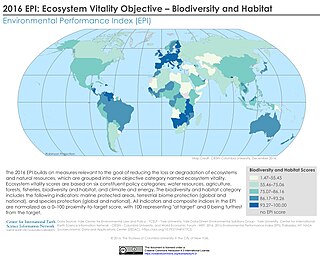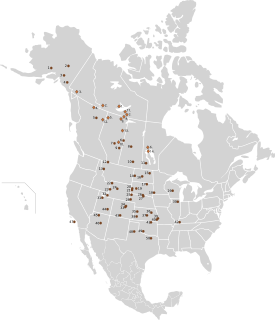Related Research Articles

Conservation biology is the study of the conservation of nature and of Earth's biodiversity with the aim of protecting species, their habitats, and ecosystems from excessive rates of extinction and the erosion of biotic interactions. It is an interdisciplinary subject drawing on natural and social sciences, and the practice of natural resource management.

Habitat conservation is a management practice that seeks to conserve, protect and restore habitats and prevent species extinction, fragmentation or reduction in range. It is a priority of many groups that cannot be easily characterized in terms of any one ideology.

Durrell Wildlife Conservation Trust is a conservation organization with a mission to save species from extinction.

Threatened species are any species which are vulnerable to endangerment in the near future. Species that are threatened are sometimes characterised by the population dynamics measure of critical depensation, a mathematical measure of biomass related to population growth rate. This quantitative metric is one method of evaluating the degree of endangerment.

The Endangered Species Act of 1973 is the primary law in the United States for protecting imperiled species. Designed to protect critically imperiled species from extinction as a "consequence of economic growth and development untempered by adequate concern and conservation", the ESA was signed into law by President Richard Nixon on December 28, 1973. The Supreme Court of the United States described it as "the most comprehensive legislation for the preservation of endangered species enacted by any nation". The purposes of the ESA are two-fold: to prevent extinction and to recover species to the point where the law's protections are not needed. It therefore "protect[s] species and the ecosystems upon which they depend" through different mechanisms. For example, section 4 requires the agencies overseeing the Act to designate imperiled species as threatened or endangered. Section 9 prohibits unlawful ‘take,’ of such species, which means to "harass, harm, hunt..." Section 7 directs federal agencies to use their authorities to help conserve listed species. The Act also serves as the enacting legislation to carry out the provisions outlined in The Convention on International Trade in Endangered Species of Wild Fauna and Flora (CITES). The Supreme Court found that "the plain intent of Congress in enacting" the ESA "was to halt and reverse the trend toward species extinction, whatever the cost." The Act is administered by two federal agencies, the United States Fish and Wildlife Service (FWS) and the National Marine Fisheries Service (NMFS). FWS and NMFS have been delegated by the Act with the authority to promulgate any rules and guidelines within the Code of Federal Regulations (CFR) to implement its provisions.

Spix's macaw, also known as the little blue macaw, is a macaw species that was endemic to Brazil. It is a member of tribe Arini in the subfamily Arinae, part of the family Psittacidae. It was first described by German naturalist Georg Marcgrave, when he was working in the State of Pernambuco, Brazil in 1638 and it is named for German naturalist Johann Baptist von Spix, who collected a specimen in 1819 on the bank of the Rio São Francisco in northeast Bahia in Brazil. This bird has been completely extirpated from its natural range, and following a several-year survey, the IUCN officially declared it extinct in the wild in 2019.
Population viability analysis (PVA) is a species-specific method of risk assessment frequently used in conservation biology. It is traditionally defined as the process that determines the probability that a population will go extinct within a given number of years. More recently, PVA has been described as a marriage of ecology and statistics that brings together species characteristics and environmental variability to forecast population health and extinction risk. Each PVA is individually developed for a target population or species, and consequently, each PVA is unique. The larger goal in mind when conducting a PVA is to ensure that the population of a species is self-sustaining over the long term.

Wildlife conservation refers to the practice of protecting wild species and their habitats in order to maintain healthy wildlife species or populations and to restore, protect or enhance natural ecosystems. Major threats to wildlife include habitat destruction, degradation, fragmentation, overexploitation, poaching, pollution and climate change. The IUCN estimates that 27,000 species of the ones assessed are at risk for extinction. Expanding to all existing species, a 2019 UN report on biodiversity put this estimate even higher at a million species. It is also being acknowledged that an increasing number of ecosystems on Earth containing endangered species are disappearing. To address these issues, there have been both national and international governmental efforts to preserve Earth's wildlife. Prominent conservation agreements include the 1973 Convention on International Trade in Endangered Species of Wild Fauna and Flora (CITES) and the 1992 Convention on Biological Diversity (CBD). There are also numerous nongovernmental organizations (NGO's) dedicated to conservation such as the Nature Conservancy, World Wildlife Fund, and Conservation International.
The Canadian Wildlife Service or CWS, is a Branch of the Department of the Environment, a department of the Government of Canada. November 1, 2012 marked the 65th anniversary of the founding of Service.

The conservation status of a group of organisms indicates whether the group still exists and how likely the group is to become extinct in the near future. Many factors are taken into account when assessing conservation status: not simply the number of individuals remaining, but the overall increase or decrease in the population over time, breeding success rates, and known threats. Various systems of conservation status exist and are in use at international, multi-country, national and local levels as well as for consumer use.

Marine conservation, also known as ocean conservation, is the protection and preservation of ecosystems in oceans and seas through planned management in order to prevent the over-exploitation of these marine resources. Marine conservation is informed by the study of marine plants and animal resources and ecosystem functions and is driven by response to the manifested negative effects seen in the environment such as species loss, habitat degradation and changes in ecosystem functions and focuses on limiting human-caused damage to marine ecosystems, restoring damaged marine ecosystems, and preserving vulnerable species and ecosystems of the marine life. Marine conservation is a relatively new discipline which has developed as a response to biological issues such as extinction and marine habitats change.

NatureServe, Inc. is a non-profit organization based in Arlington County, Virginia, US that provides proprietary wildlife conservation-related data, tools, and services to private and government clients, partner organizations, and the public. NatureServe reports being "headquartered in Arlington, Virginia, with regional offices in four U.S. locations and in Canada." In calendar year 2011 they reported having 86 employees, 6 volunteers, and 15 independent officers.

Captive breeding, also known as "captive propagation", is the process of maintaining plants or animals in controlled environments, such as wildlife reserves, zoos, botanic gardens, and other conservation facilities. It is sometimes employed to help species that are being threatened by human activities such as habitat loss, fragmentation, over hunting or fishing, pollution, predation, disease, and parasitism. In some cases a captive breeding program can save a species from extinction, but for success, breeders must consider many factors—including genetic, ecological, behavioral, and ethical issues. Most successful attempts involve the cooperation and coordination of many institutions.
An endangered species recovery plan, also known as a species recovery plan, species action plan, species conservation action, or simply recovery plan, is a document describing the current status, threats and intended methods for increasing rare and endangered species population sizes. Recovery plans act as a foundation from which to build a conservation effort to preserve animals which are under threat of extinction.
Genetic erosion is a process where the limited gene pool of an endangered species diminishes even more when reproductive individuals die off before reproducing with others in their endangered low population. The term is sometimes used in a narrow sense, such as when describing the loss of particular alleles or genes, as well as being used more broadly, as when referring to the loss of a phenotype or whole species.

An endangered species is a species that is very likely to become extinct in the near future, either worldwide or in a particular political jurisdiction. Endangered species may be at risk due to factors such as habitat loss, poaching and invasive species. The International Union for Conservation of Nature (IUCN) Red List lists the global conservation status of many species, and various other agencies assess the status of species within particular areas. Many nations have laws that protect conservation-reliant species which, for example, forbid hunting, restrict land development, or create protected areas. Some endangered species are the target of extensive conservation efforts such as captive breeding and habitat restoration.

Manatees are large marine mammals that inhabit slow rivers, canals, saltwater bays, estuaries, and coastal areas. They are a migratory species, inhabiting the Florida waters during the winter and moving as far north as Virginia and into the Chesapeake Bay, sometimes seen as far north as Baltimore, Maryland and as far west as Texas in the warmer summer months. Manatees are calm herbivores that spend most of their time eating, sleeping, and traveling. They have a lifespan of about 60 years with no known natural enemies. Some of their deaths are the result of human activity. In the past, manatees were exploited for their meat, fat, and hides.

Throughout the 18th and 19th centuries, the plains bison and wood bison in Canada were hunted by nomadic indigenous hunters and white hunters alike. By the 1850s, the bison was nearly extinct, spurring a movement to save the few herds that remained. Federal government wildlife policy evolved from preservation of wilderness to utilitarian, scientific conservation and management of bison populations. The goals of these policies were often contradictory: to simultaneously preserve wildlife, promote recreation, commercialize the bison, and assert state control over Aboriginal Canadians. Bison conservation efforts were shaped by the federal government's colonialist and modernist approach to Canada's North, the management of national parks and reserves, and the influence of scientific knowledge.
The Wildlife Conservation Society Canada, based in Toronto, Ontario, is the Canadian affiliate of the Wildlife Conservation Society International (WCS), incorporated as a conservation organization in Canada in July 2004. WCS Canada currently runs conservation projects across six key regions in Canada led by its staff of field-based scientists.

The Torreya Guardians is a self-organized group of conservationists dedicated to facilitating the assisted migration of the Florida torreya by rewilding it further north than its native range in Florida and Georgia. Founded in the early 2000s, the group is often mentioned as an instigator of the assisted migration of forests in North America for conservation and climate adaptation purposes. It is an example of citizen-initiated citizen science.
References
- ↑ Gerber, Leah (Dec 2016). "A Nation of Noahs". A\J: Alternatives Journal . Retrieved 18 February 2018.